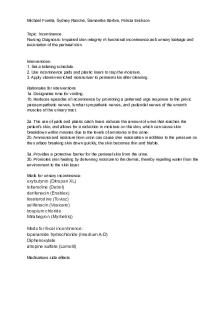Nursing Diagnosis FVD PDF

| Title | Nursing Diagnosis FVD |
|---|---|
| Author | Sharon Cohen |
| Course | NUR1211 |
| Institution | Keiser University |
| Pages | 1 |
| File Size | 85 KB |
| File Type | |
| Total Downloads | 97 |
| Total Views | 149 |
Summary
Care plan fluid volume overload and other care plan...
Description
Priority # Nursing Diagnosis 1: Deficient Fluid Volume r/t C. diarrhea aeb active fluid volume loss NURSING Assessment focused on NSG DIAGNOSIS
OUTCOMES
O: Patient looks dizzy. Patient weak.
S.T Goals Maintain normal blood pressure, heart rate, and body temperature within the hour (Ackley, Ladwig, Makic, Kratz, et al., 2019)
INTERVENTIONS
Nurse will monitor pulse, respirations and blood pressure of clients with DFV every 15 minutes to 1 hour for the unstable client. (Ackley, Ladwig, Makic, Kratz, et al., 2019)
RATIONALES
EVALUATION
Vital signs changes are seen with fluid volume deficit include tachycardia, tachypnea, decreased BP at first, then hypotension, decreased blood volume. These are clinical signs of dehydration that need fixing.
Goal: Met. Patient has normal BP, HR and temperature.
(Ackley, Ladwig, Makic, Kratz, et al., 2019)
S: Potassium 3.2 Creatnine 1.4 BP:100/60 and decreasing to 92/48 T:100.2 P:104 and increased to 120.
Provide oral replacement therapy as ordered and tolerated with a hypotonic glucose – electrolyte solution when the client has acute diarrhea and or n/v.
Maintain elastic skin turgor; moist tongue and mucous membranes; and orientation to person, place and time within 2 hours. (Ackley, Ladwig, Makic, Kratz, et al., 2019)
(Ackley, Ladwig, Makic, Kratz, et al., 2019)
Makic, Kratz, et al., 2019)
Nurse will provide fresh water and oral fluids preferred by the client. Frequent drinks, fresh fruit as prescribed.
Distributing the intake over 24 hours and providing snacks, specifically those with creatine may improve muscular ability, endurance and alertness.
(Ackley, Ladwig, Makic, Kratz, et al., 2019)
When ordered, initiate a fluid challenge of crystalloids for replacement of intravascular volume. (Ackley, Ladwig, Makic, Kratz, et al., 2019)
L.T Goal Explain measures that can be taken to treat or prevent fluid volume loss by end of shift. (Ackley, Ladwig, Makic, Kratz, et al., 2019)
Maintenance of oral intake stabilizes the ability of the intestines to absorb nutrients. They increase net fluid absorption. (Ackley, Ladwig,
Teach the client about the importance of how to measure and record intake and output accurately. (Ackley, Ladwig,
(Ackley, Ladwig, Makic, Kratz, et al., 2019)
Goal: Met. Patient is oriented x3 and has proper skin turgor.
Guidelines set by EGDT developed to prevent sepsis. (Ackley, Ladwig, Makic, Kratz, et al., 2019)
Body weight change of I kg represents fluid loss of 1 L. (Ackley, Ladwig, Makic, Kratz, et al., 2019)
Makic, Kratz, et al., 2019)
Teach the client about measures instituted to treat hypovolemia and to prevent or treat fluid volume loss. (Ackley, Ladwig,
This enables the patient to know signs of FVD and when it is indicated to contact the health care provider. (Ackley, Ladwig,
Makic, Kratz, et al., 2019)
Makic, Kratz, et al., 2019)
Goal: Met. Patient knows s+s of hypovolemic shock and when to call physician....
Similar Free PDFs

Nursing Diagnosis FVD
- 1 Pages

Nursing diagnosis
- 2 Pages

Nursing Diagnosis
- 5 Pages

Nanda Nursing Diagnosis
- 7 Pages

Nanda Nursing Diagnosis list
- 16 Pages

Nursing diagnosis by maslows
- 9 Pages

Nursing Diagnosis for MIU
- 1 Pages

Nursing Diagnosis for Sepsis
- 8 Pages

Chapter 7 Nursing Diagnosis
- 1 Pages

Wizard of OZ Nursing Diagnosis
- 4 Pages
Popular Institutions
- Tinajero National High School - Annex
- Politeknik Caltex Riau
- Yokohama City University
- SGT University
- University of Al-Qadisiyah
- Divine Word College of Vigan
- Techniek College Rotterdam
- Universidade de Santiago
- Universiti Teknologi MARA Cawangan Johor Kampus Pasir Gudang
- Poltekkes Kemenkes Yogyakarta
- Baguio City National High School
- Colegio san marcos
- preparatoria uno
- Centro de Bachillerato Tecnológico Industrial y de Servicios No. 107
- Dalian Maritime University
- Quang Trung Secondary School
- Colegio Tecnológico en Informática
- Corporación Regional de Educación Superior
- Grupo CEDVA
- Dar Al Uloom University
- Centro de Estudios Preuniversitarios de la Universidad Nacional de Ingeniería
- 上智大学
- Aakash International School, Nuna Majara
- San Felipe Neri Catholic School
- Kang Chiao International School - New Taipei City
- Misamis Occidental National High School
- Institución Educativa Escuela Normal Juan Ladrilleros
- Kolehiyo ng Pantukan
- Batanes State College
- Instituto Continental
- Sekolah Menengah Kejuruan Kesehatan Kaltara (Tarakan)
- Colegio de La Inmaculada Concepcion - Cebu





